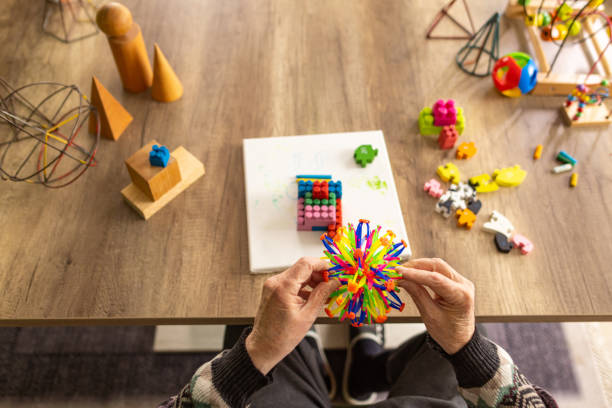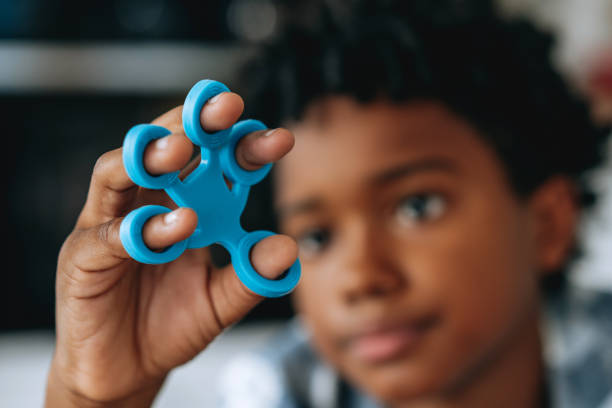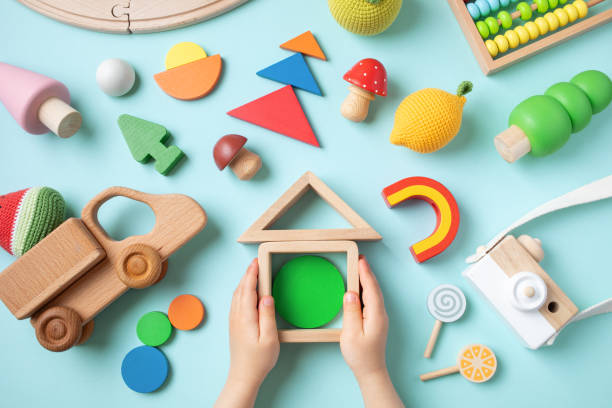Why Hand Sensory Toys Deserve More Attention
Nowadays, sensory toys for hands are no longer just a trend and a toy, but a powerful tool for enhancing cognitive development, improving focus, and promoting emotional well-being. We need more and more stimulation for our mental strength and richer and stronger perception and optimization of our senses in life. Often collectively referred to as “fingertip toys” or “hand fidget toys,” these seemingly simple gadgets range from finger toys to specialized hand fidget toys, engaging the senses through touch and movement, and have profound neurological effects that are particularly beneficial for children with autism, ADHD, and even adults struggling with anxiety or stress.
It’s worth breaking out of the box to explore how tactile stimulation through the hands can impact cognitive and motor development, emotional regulation, and even sensory integration, while also introducing some lesser-known variations, such as single-finger fidget toys and hand-cranked fidget toys. And how to use them effectively, focusing on their unique role in meeting sensory needs.
What Are Sensory Toys for Hands, Functions Really Useful?
At their core, sensory hand toys provide tactile, proprioceptive, and sometimes auditory feedback through grasping, rolling, pressing, or manipulation. Unlike purely recreational toys, they range from simple fidget toys to more complex tools like hand exercisers and tactile toys, catering to a variety of sensory needs.These tools often focus on stimulating the fingers, palms, and hand muscles, which have dense sensory nerve endings.
These toys are particularly useful for people who need additional sensory input to regulate their nervous systems, such as those with autism spectrum disorder (ASD), attention deficit hyperactivity disorder (ADHD), or sensory processing disorder (SPD). However, their appeal is universal, relieving stress and improving focus even in the neurotypical population.
Key Features of Hand Sensory Toys
- Tactile Engagement: They provide varied textures and sensations, stimulating the sense of touch.
- Kinesthetic Stimulation: Movements like spinning, squeezing, or rolling activate proprioception, enhancing body awareness.
- Portability: Their small size makes them ideal for use in classrooms, offices, or on the go.
- Customizability: Options for different textures, weights, and sounds allow for personalized sensory experiences.

How Do They Support Boosting Brain and Motor Skills
Research highlights the significant impact sensory play can have on children’s cognitive and motor development. Playing with sensory toys that stimulate the hands strengthens neural connections in the brain, boosting memory, problem-solving skills, and hand-eye coordination. When children play with toys that stimulate the hands, they’re not just playing with their hands, but also improving grasp control, spatial perception, and bilateral coordination. A 2022 study in the Journal of Developmental and Behavioral Pediatrics reported that children who used fine motor stimulation toys showed a 28% improvement in sustained attention compared to children who did not use tactile stimulation.
Fine motor activities stimulate the cerebellum and prefrontal cortex — areas that are important for coordination, planning, and emotional regulation. These activities strengthen hand muscles and improve dexterity. Additionally, sensory toys promote language development as children use different textures and shapes to express their experiences, which can promote vocabulary growth. While sensory play primarily targets fine motor skills, it can also indirectly support gross motor skills through activities that involve larger movements, such as stacking textured blocks, Le Toy Van, and more.
| Benefit | Description | Example Toys |
|---|---|---|
| Cognitive Development | Enhances memory, problem-solving, and cause-and-effect understanding | Kinetic sand, sensory bins |
| Fine Motor Skills | Improves hand strength, dexterity, and coordination | Stress balls, putty |
| Language Skills | Encourages description of textures and shapes | Textured blocks, Play-Doh |
| Gross Motor Skills | Supports larger movements indirectly | Stacking toys, sensory tubes |
Beyond Play: Hand Toys Enhance Sensory Perception And Promote Learning
Hand fidgets play a crucial role in improving sensory perception,the chewable hand toys will optimize sensory needs and relieve the stress of fidgeting,particularly for individuals with sensory processing disorders:
- Tactile Stimulation: Fidgets provide consistent tactile feedback, helping the brain process touch more effectively.
- Sensory Integration: By engaging multiple senses (touch, sight, and sometimes sound), fidgets aid in organizing sensory information, reducing sensory overload.
- Proprioceptive Input: Manipulating fidgets enhances awareness of body position and movement, improving spatial awareness.
- For individuals with autism or SPD, fidgets act as a bridge to a more regulated sensory state, as supported by Golden Care Therapy.
The connection between movement and learning is well-documented. By engaging in tactile hand activity, children and adults often experience:
- Better retention of information
- Decreased impulsivity
- Greater comfort in structured settings (e.g., classrooms)
Even occupational therapists are incorporating hand sensory tools into cognitive training, speech therapy, and early intervention programs.

Hand Fingertip Toys for Sensory Stimulation and Attention Regulation
Hand fingertip toys are specifically designed to provide sensory stimulation and support attention regulation:
- Sensory Stimulation: Toys like Single Finger Fingertip Toys and Metal Finger Fingertip Toys offer unique tactile experiences, engaging the senses and promoting calmness.
- Attention Regulation: The repetitive motions of Hand Crank Roller Fingertip Toys help channel excess energy, improving focus and reducing hyperactivity.
- These toys are particularly effective for sensory seekers, such as children with autism, who benefit from the predictable sensory input they provide.
Benefits for Children with Autism and Sensory Processing Needs
Children with autism often face challenges with sensory processing and have difficulty filtering sensory information. In daily care of children, you will often find a question: What should I do if my child has autism and likes to chew things?This is a difficulty that children have in responding to, filtering and processing sensory needs.So at this time, even if it is a hand sensory toy, it is best to choose some chewable sensory toys.
Hand-held sensory toys can provide a safe and controlled way to meet their need for high sensory input, helping them self-regulate and manage sensory overload. In particular, fidget toys are a powerful tool in applied behavior analysis (ABA) programs, acting as reinforcers to attract attention and improve focus.
For sensory seekers—children who crave intense sensory input—fidget toys, such as stretchy bands or stuffed animals, can provide tactile stimulation to calm them and keep them focused. These toys can reduce anxiety, improve focus, and reduce self-stimulatory behaviors, making them an indispensable tool in educational settings.
A study in the American Journal of Occupational Therapy found that fidget toys can reduce hyperactivity and improve focus in children with ADHD (often with autism). Research in Contemporary Psychology shows that parents of children with autism find fidget toys very beneficial in reducing anxiety. Combined with more relevant research, it can be shown that sensory toys can help children with autism process information better, improve communication skills, and learn.
A Deeper Dive-Are Hand Sensory Toys Good for Children with Special Educational Needs?
Children with special educational needs, including dyspraxia, ADHD and sensory integration disorder, often benefit from structured, predictable hand activities. Unlike open-ended toys, fingertip sensory toys have a rhythmic and predictable feel, which can stabilize the nervous system.
Research Confirms Benefits
Fine motor skills: These toys require precise finger movements, improving dexterity and hand-eye coordination, which is crucial for children with SEN who may have difficulty with tasks such as writing or self-care.
Sensory integration: They provide tailored sensory input, helping children with SEN process sensory information more effectively.
Adaptability: Many fingertip toys can be adjusted to individual needs, ensuring an inclusive play experience.
Engaging: As experts at the National Autism Resource Centre point out, the engaging nature of fingertip toys makes them effective therapy and play tools.
Useful Product Examples
Textured silicone hand pads for touch seekers
Weighted palm rollers for proprioceptive feedback
Metal finger tip toys that add subtle auditory input by clicking or spinning

Maximizing the Benefits of Hand Sensory Toys
To ensure sensory toys for hands are effective, consider the following strategies:
- Choose Appropriate Fidgets: Select toys that align with the child’s sensory needs and the setting. For example, silent rollers like the ONO Roller are suitable for quiet environments ONO.
- Set Clear Usage Rules: Define when and where fidgets can be used to prevent them from becoming distractions.
- Monitor Impact: Observe how the fidget affects focus and adjust the type or usage if necessary.
- Integrate into Routines: Use fidgets during activities requiring sustained attention, such as reading or group discussions.
- Match Physical Abilities: Ensure the child has the motor skills to use the fidget effectively Performance Health Links.
These strategies help tailor the fidget experience, enhancing its benefits for focus and relaxation.
Types Of Sensory Toys For The Hands And How To Choose?
Hand sensory toys come in various forms, each designed to meet specific sensory and developmental needs. Below is a breakdown of the main categories, including the specialized sensory fidget toys for hands mentioned in the query.
| Type | Examples | Primary Benefits |
|---|---|---|
| Fidget Toys | Fidget spinners, Pop Its, Tangle toys,Fidget Necklaces | Improves focus, reduces anxiety |
| Hand Exercisers | Grip strengtheners, therapy putty | Enhances fine motor skills, hand strength |
| Tactile Toys | Textured balls, sensory tubes | Boosts tactile awareness, sensory integration |
| Single Finger Fingertip Toys | Finger poppers, mini spinners | Develops fine motor skills, discreet use |
| Hand Crank Roller Fingertip Toys | Knuckleroller, finger rollers | Promotes dexterity, sensory stimulation |
| Metal Finger Fingertip Toys | Metal spinners, fidget rollers | Offers stress relief, unique tactile experience |
When selecting a hand fidget toy, consider the following:
| Feature | Why It Matters |
|---|---|
| Texture | Engages touch-based sensory seekers |
| Resistance Level | Provides proprioceptive input, calming the system |
| Size and Portability | Important for discreet use in school/work settings |
| Material (metal/silicone) | Can impact auditory and tactile feedback |
For example, Hand Crank Roller Fingertip Toys offer repetitive, circular motion ideal for soothing overstimulated minds, while Metal Finger Fingertip Toys introduce weight and spin for more advanced tactile feedback.
Sensory Toys For Hands May Seem Trivial, But A Big Change
Sensory toys for hands are not a passing fad, they are transformative tools that promote cognitive development, motor skills, sensory integration, and emotional regulation. They offer functional benefits rooted in neuroscience and real-world applications.For children with autism or other special educational needs, sensory fidget toys for hands offer tailored sensory input, helping manage sensory overload, enhance focus, and reduce anxiety. Specialized types like Single Finger Fingertip Toys, Hand Crank Roller Fingertip Toys, and Metal Finger Fingertip Toys provide unique tactile experiences, making them versatile additions to therapy and daily life.
As research continues to explore their benefits, these toys remain a valuable resource for fostering growth, calm, and connection in a sensory-rich world.Whether you’re a parent, teacher, or an adult just trying to focus, this simple stress-relieving hand toy might just be your most powerful (and pocket-sized) ally.


